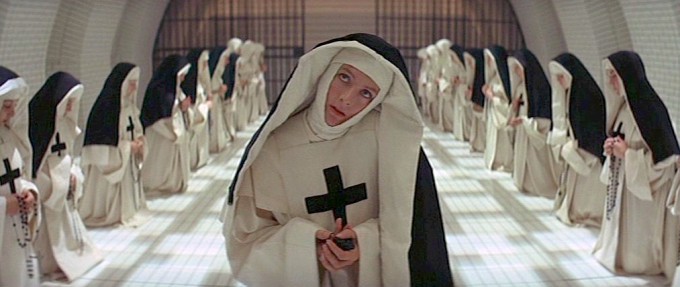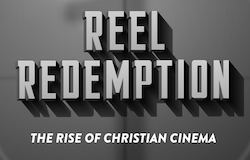The Sacred and the Profane, by Reed Lackey
18 Mar
For decades, a notorious film by director Ken Russell provoked debate, controversy, and sometimes disgust in audiences who had the rare privilege to see it. Banned in several countries around the world, and lacking formal distribution in any others, The Devils was one of film connoisseurs’ most heavily sought lost treasures. Warner Brothers began a rocky distribution in the early 2000s, releasing the film in limited printings, with sub-par video quality, on DVD. It appeared on iTunes in 2010, only to be removed again without explanation after only 3 days. Even these few releases removed the more severely controversial moments of the film, and a complete version remains extremely elusive, if not entirely lost.
However, just this week, the horror-exclusive streaming service Shudder presented the film as a surprise to its subscribers with almost no prior publicity. The film they present is still somewhat censored (missing two of the film’s most notorious moments), but is the first time an unrated print of the film has been made widely available to streaming audiences. It is an undeniably provocative and challenging film, in almost equal parts perverse and profound, but ultimately very effective.
The story, based on historical accounts, tells of the 17th century French town of Loudon, and specifically of its highly-regarded spiritual and civil leader, Urbain Grandier. It is a time of tremendous political shifting in France, and Cardinal Richelieu (a historical villain who has made appearances in several classic literary masterpieces) is negotiating with King Louis XIII for increased power and influence. The one town where the Cardinal’s influence does not yet reach is Loudon, where Father Grandier (played by Oliver Reed) maintains social and spiritual order as both the town’s priest and its acting governing agent.
Grandier is a complicated figure. He is devout and sincere in both his faith and his care for the people, but he is also a man who indulges pleasures condemned by the larger church body (including, most notably, sexual relationships). He is also highly critical of the ever-increasing influence of Cardinal Richelieu and very protective of the people of his town from Baron Laubardemont, who seeks to expand that influence. What Grandier doesn’t know is that a local nun, Sister Jeanne (played by Vanessa Redgrave), is madly obsessed with him and has continual sexual fantasies that involve him appearing as Jesus to her. When Grandier secretly marries a local woman, Sister Jeanne informs the town’s new confessor, Father Mignon, about Grandier’s affairs and his marriage. In the process, she also implies that Grandier is guilty of witchcraft and has possessed her in cooperation with the devil. Mignon informs Baron Laubardemont, who seizes the opportunity to try to destroy Grandier and take over the town of Loudon.
The film’s controversies largely revolve around the events following this plot point. With the exception of Sister Jeanne’s provocative fantasy sequences, all of the film’s more upsetting scenes take place in its last half. Baron Laubardemont, caring little for the church apart from its political capital, invites an eccentric (and possibly insane) inquisitor named Father Barre to come and question the nuns about Father Grandier and their supposed possessions. Barre’s methods are extreme (and occasionally perverse) and even when King Louis XIII appears in disguise (for his own amusement) and proves that the possessions are fraudulent and a hoax, the hysteria persists. The nuns devolve into sexual expressions that are unrestrained and wildly erratic. When Grandier finally returns from a brief seclusion with his new wife – carrying in his heart increased devotion to both God and his people – he is immediately arrested for the crime of witchcraft and coercion with the devil as a result of the perversity on display.
Director Ken Russell – who was a believing, practicing catholic at the time he made The Devils – has crafted a film of undeniable power. Its more disturbing and challenging sequences are often deeply offensive, but this is, to a degree, their intent. By contrasting the character of Grandier (who is admittedly sinful yet remains sincerely pious) with the characters of Barre, Mignon, and Laubardemont (who outwardly profess to be doing God’s work yet clearly remain motivated by political power and personal control), Russell has successfully indicted the horror of hypocrisy and of living a life which continually takes the name of God in vain. Several sequences are deliberately profane, but they are not unfocused. They carry the weight of a storyteller who understands that this story is offensive and remains unafraid to offend in the telling of it.
The film’s most controversial moment was absent from the version presented on Shudder. It depicts a convent of nuns who, after their possessions are revealed to be a hoax, erupt into an orgy and sexually assault the crucifix centered at the front of the church. While I was braced for this scene, I must admit to no small degree of relief that it was not in the version I saw. Yet, having seen the rest of the film, I think I understand something of what the director is trying to say with such an obscene moment. By presenting characters who perpetually pose as righteous – who declare that they are doing God’s work while they unabashedly abandon reason and compassion and pursue unity with a political agenda – Russell seems to be saying that they are perverting Christ’s work, and are not merely abusing God’s people, but abusing the sanctity of the cross and of Christ himself. It is an offensive thing to say, but perhaps it is no less offensive than the behavior which it is indicting.
Russell continually insisted that his film was a Christian film, telling the story of a “sinner who becomes a saint” and of the treacherous intersection between church and state. Grandier suffers tremendously before ultimately paying the ultimate price for his integrity. He is – by his own admission – guilty of great sin, but innocent of the crimes for which he is being tortured. Oliver Reed delivers perhaps his most powerful work as an actor, endowing Grandier with a compelling mixture of terror and courage that is profound and unforgettable. Even in the height of his suffering, he condemns the church for abandoning him, yet begs and praises God not to do the same. The people realize, far too late, that they have made a horrific mistake and all they are left with is rubble, ash, and madness, while the political rulers that broke each of them (except Grandier) dismissively move on to whatever’s next.
The film is more than 40 years old, but its themes remain terrifyingly relevant. It is difficult to recommend the film without the warning that it is deeply offensive, but it is hard not to acknowledge the tremendous power of storytelling on display in it. In lesser hands, this story would be regarded as perverse and demented. Some may still regard it that way, but Russell’s direction is too focused and assured for me to do so. I am troubled by this story, but even more so by the fact that (at least to some degree) it is a true story. This happened, and unfortunately it may yet happen again.
The villains in the story were indeed possessed by the devil’s work, but in a far more deceptive and treacherous way than they could have imagined. They were seduced by the lusts of their flesh and their hunger for political power to destroy the very hope for salvation they claimed to represent. These are the “devils” of the film’s title: those who would take the holy work of ministering to people, and use it to serve only themselves.




No comments yet